Everyone enjoys the brief and sometimes dazzling streaks of light from meteors, sometimes called "shooting stars." Sky & Telescope predicts that the two best meteor showers in 2017 will be the Quadrantids in early January and the Geminids in mid-December.
If you watch the starry night sky from a dark location, a few times every hour you'll see brief streaks of light from meteors, sometimes called "shooting stars." They can catch your eye just at the limit of visibility or be dramatically bright fireballs that appear brighter than Venus and light up the nightscape around you. The rarest of these, called a bolide, shatters into pieces during its rapid descent.
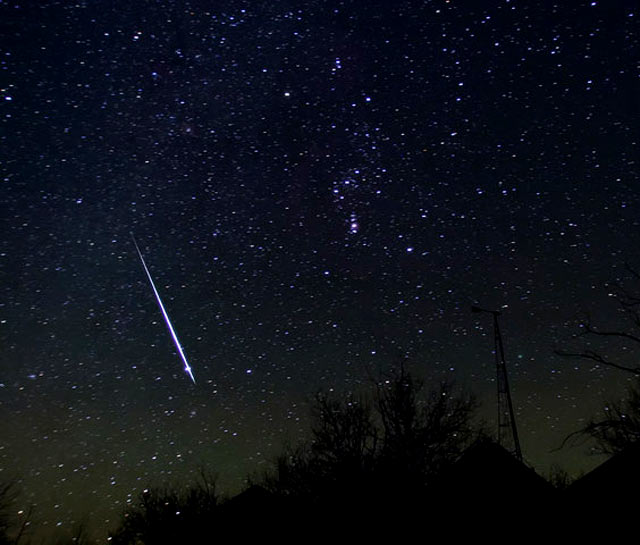
Derived from the Greek word meteoros (meaning "high in the air"), meteors are bits of interplanetary debris slamming into Earth's upper atmosphere at altitudes of 80 to 120 km (50 to 75 miles).
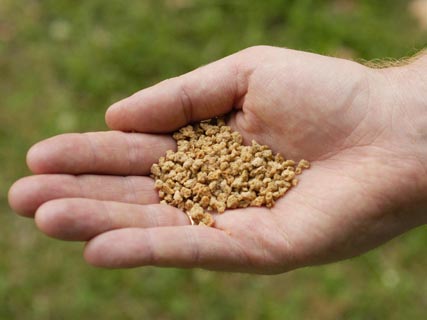
J. Kelly Beatty
The particles themselves are not large — typically they're no bigger than big sand grains, and something the size of a pea can create a meteor that's dramatically bright. That's because they strike at 30 to 70 km (20 to 45 miles) per second, and all that kinetic energy is rapidly dissipated by frictional heat.
In fact, we see a meteor's streak not because the particle is "burning up," but instead because air molecules along its path become flash-heated to thousands of degrees.
Meteors can occur at any time on any night and appear in any part of the sky. On most nights a half dozen of these sporadic (random) meteors appear hourly, which is what you can expect from the meteor showers in 2017.
What is a Meteor Shower?
However, several times each year, Earth encounters a stream of gritty debris left in space by a passing comet, and the result is a meteor shower. You'll notice the difference if you watch the sky for a half hour or so during one of these events: not only do the number of meteors you'll see go up, but also the meteors seem to fly away from a common point in the sky called the radiant. This is a trick of perspective, because all these particles are traveling in parallel — part of a vast but sparse "river of rubble" that's spread all around the comet's orbit.
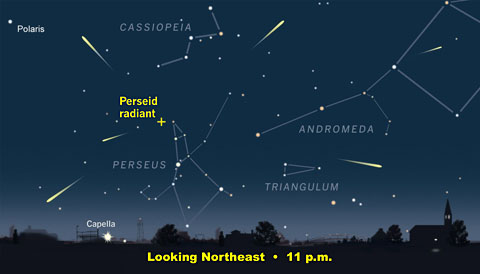
Sky & Telescope diagram
A shower gets its name from the constellation where this radiant lies — for example, August's well-known Perseid shower has its radiant in Perseus, as shown in the illustration at right.
One notable exception to this rule is the Quadrantid shower, named for the now-defunct constellation Quadrans Muralis. Its radiant lies in the constellation Boötes. In any case, the higher a shower’s radiant, the more meteors it produces all over the sky.
Meteor showers usually peak during the predawn hours on the dates listed below, though they're typically active a few nights before and after the peak date. Note that the rates are for ideal conditions: very dark skies free of moonlight or light pollution, with the radiant nearly overhead. Most likely you'll see somewhat lower rates than those listed. Following the table are specific predictions for each shower's prospects during 2017.
Dynamicists have gotten rather good at predicting when a particular shower might display an extra burst of activity. Usually these are from concentrated "ribbons" of particles that might have been ejected by the parent comet decades or even centuries ago. However, no such outbursts have been predicted for any of the known meteor showers in 2017. It's shaping up to be a relatively normal year.
For the best possible viewing experience for meteor showers in 2017, find a dark location, make yourself comfortable in a reclining chair, and wear plenty of warm clothing (as appropriate). And for more information on watching and studying meteors, see our article on meteor basics and the other articles in the Meteor section of our website.
Get the best meteor showers 2017 experience with our free guide to meteor observing, with resources for beginners and experienced amateurs alike. Our FREE Shooting Stars eBook covers the history, art, and science of meteor showers; just enter your email address below to access this download.
[form id="246617506"]
| Major Meteor Showers in 2017 | ||||
| Shower | Radiant and direction | Morning of maximum | Best hourly rate | Parent |
| Quadrantid | Draco (NE) | Jan. 3 | 60-100 | 2003 EH1 |
| Lyrid | Lyra (E) | April 22 | 10-20 | Thatcher (1861 I) |
| Eta Aquariid* | Aquarius (E) | May 6 | 20-60 | 1P/Halley |
| Delta Aquariid | Aquarius (S) | July 30 | 20 | 96P/Machholz |
| Perseid* | Perseus (NE) | Aug. 12 | 90 | 109P/Swift-Tuttle |
| Orionid | Orion (SE) | Oct. 21 | 10-20 | 1P/Halley |
| Southern Taurid* | Taurus (S) | Nov. 5 | 10-20 | 2P/Encke |
| Leonid | Leo (E) | Nov. 17 | 10-20 | 55P/Tempel-Tuttle |
| Geminid | Gemini (S) | Dec. 14 | 100-120 | 3200 Phaethon |
* Strong moonlight will interfere with these showers.
Must-See Meteor Showers in 2017
January 3: The Quadrantids
The brief but active "Quads" peak near 14h Universal Time on January 3rd. That corresponds to 9 a.m. EST (a few hours after dawn) and 6 a.m. PST, so this timing generally favors viewing from North America, especially in the Far West. The "Quads" can in theory deliver at least 1 meteor per minute under excellent sky conditions — the idealized zenithal hourly rate (ZHR), for someone with perfectly dark skies and the meteor's radiant overhead — is a very high 120. But in practice few observers ever see anything close to this many, because the shower's maximum activity lasts only several hours and is easy to miss.
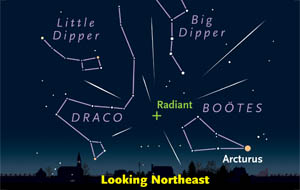
Sky & Telescope diagram
April 22: The Lyrids
As with the Quadrantids, April's Lyrid shower puts on a fairly brief performance. This hasn't been a particularly strong display in recent years, though counts exceeded one per minute during an outburst in 1982. The predicted peak (12:00 UT on April 22nd) is timed well for western North America, and light from a waning crescent Moon won't be a problem. Look for a few meteors per hour emanating from a radiant near the Hercules-Lyra border after darkness falls on the 21st.
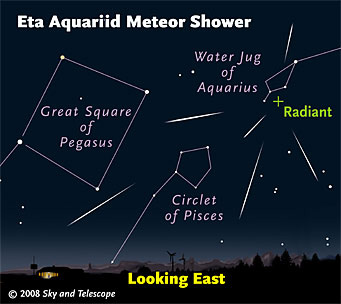
Sky & Telescope diagram
May 6: The Eta Aquariids
This annual shower originates from none other than Halley's Comet, and these meteors come in fast — 66 km (41 miles) per second! At its best, under ideal conditions, the Eta Aquariids can deliver a meteor per minute at its peak, which this year should occur near 2:00 UT on May 6th. Note that the shower's radiant (in the Water Jar asterism of Aquarius) never gets very high above the horizon for observers in the Northern Hemisphere. It rises only a couple of hours before dawn — just about when a fat gibbous Moon will be setting in the west. This shower is seen better from the tropics or the Southern Hemisphere.
July 30: The Delta Aquariids
You might see this long-lasting shower called the Southern Delta Aquariids, because its radiant is below the celestial equator and thus best seen from the Southern Hemisphere. Light from a waxing crescent Moon will not interfere, but Delta Aquariids tend to be faint — so don't count on seeing more than a few of these meteors per hour unless you are observing from a very dark site.
August 12: The Perseids
Even casual skywatchers know about the Perseid meteor shower, because it can deliver at least one meteor per minute under pleasant summer skies. These meteors are bits of debris shed by comet 109P/Swift-Tuttle, which orbits the Sun every 130 years.
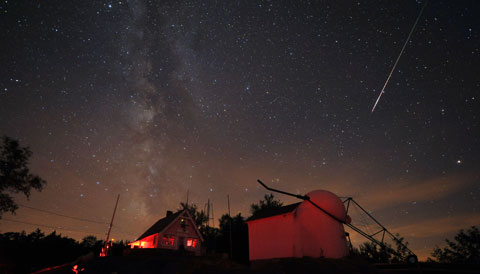
Dennis di Cicco
The shower's peak performance is relatively brief, so timing is important. According to the International Meteor Organization, the shower's 2017 maximum should come between 14:00 UT on August 12th and 2:30 UT on the 13th. The midpoint of that range is about 20:00 UT, which is during daylight in North America. Moreover, the Moon, a few days past full, will rise around 10 p.m. on the 12th and wash out most of the Perseids. So start watching on the evening of the 12th as soon as it's gotten dark and the radiant (near the Double Cluster in Perseus) clears the horizon.
October 21: The Orionids
Here's another modest shower due to Halley's Comet. This shower lasts nearly a month, and this year its peak falls on October 21st. That's great timing, because the Moon will be new and no issue whatsoever. The shower’s radiant is located above Orion’s bright reddish star Betelgeuse, close enough to the celestial equator for observers in both the Northern and Southern hemispheres to enjoy the show. You might glimpse 10 or more Orionids per hour from a dark site in the hours before dawn.
November 5: The Southern Taurids
Lasting from mid-September to mid-November, this broad, weak display typically produces at most a dozen meteors per hour at its peak. But in 2005 skywatchers were treated to a "Taurid fireball swarm" dominated by bright, slow-moving fireballs from larger-than-average particles. Don't expect Taurid fireworks this year, however, because a full Moon will spoil the show when the shower peaks at 12:00 UT on November 5th. The shower’s radiant is in western Taurus, along its border with Cetus.
November 17: The Leonids
The Leonid shower's parent comet, 55P/Tempel-Tuttle, tends to create narrow concentrated streams of debris that produced prodigious displays in the late 1990s, when it last swung close to the Sun. Since then the shower's activity has varied from year to year, usually offering little more than a trickle of shooting stars radiating from Leo’s Sickle. But the good news is that, during this year's peak (17:00 UT on November 17th), the new Moon will not hinder observations.
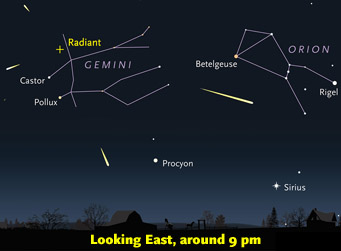
Sky & Telescope diagram
December 14: The Geminids
Out of all the meteor showers in 2017, this end-of-the-calendar shower is usually the year’s best and most reliable, with upward of 100 meteors per hour radiating from a spot near the bright star Castor. Even better, the Geminid radiant is well up in the sky by 9 p.m. as seen from at mid-northern latitudes. The Geminids last for a couple of weeks in the first half of December, and the shower's brief peak is predicted for the 14th at 6:30 UT — excellent timing for North America. More good news is that the waning crescent Moon will be just a couple days from new.
Geminid meteors come from 3200 Phaethon, an asteroid discovered in 1983 that circles the Sun every 3.3 years. In fact, recent observations suggest that Phaethon might be a "rock comet" that sheds particles when its surface heats up to roughly 1,300°F (700°C) at each perihelion.
Keep tabs on meteor showers in 2017 and all the year's other celestial happenings with SkyWatch 2017, now also available as a digital edition.
 9
9








Comments
P.Michael-Hutchins
January 7, 2017 at 8:46 am
nice to hear about the brief-peaked 3JAN Quadrantids on 4JAN
You must be logged in to post a comment.
J. Kelly BeattyPost Author
January 7, 2017 at 2:52 pm
fair enough, but we posted an entire article about viewing the Quads on December 28th (http://skyandtelescope.org/astronomy-news/catch-the-quadrantid-meteors-if-you-can/)
You must be logged in to post a comment.
P.Michael-Hutchins
January 29, 2017 at 4:11 pm
sorry: I should have had occur to me the expectation that you-all would've done something like that. Might've, if I hadn't used up all my neuron-firings to complain.
You must be logged in to post a comment.
P.Michael-Hutchins
January 29, 2017 at 4:08 pm
It would be useful to include the effect of the prevailing moonlight for each shower.
You must be logged in to post a comment.
Graham-Wolf
February 8, 2017 at 12:24 am
Thanks Kelly, for your thoughtful and timely preview.
When I'm not chasing comets out there, I must keep a lookout for a few southern meteor showers (used to be heavily involved in IMO in the late 1980s)! Kiwi:- Ronald McIntosh was a legendary meteor pioneer in the 1930's, who mapped the first decent radiants down here. For those with say:- Stellarium, they will be able to pre-test for any lunar pollution on the desired observing dates. Good luck to all! Regards from 46 South, NZ. Graham W. Wolf.
You must be logged in to post a comment.
Cannalinadays
June 11, 2017 at 10:15 am
6:30P.M. UT is 2:30 P.M. In North America Geminis section. Is there a mistake?
You must be logged in to post a comment.
jantiemen
September 30, 2017 at 1:20 pm
Why do particles from a comet spread all over their orbit? You would expect more particles close to the comet, right? How long would it take to distribute the particles over the whole orbit? Many revolutions, I would figure.
You must be logged in to post a comment.
J. Kelly BeattyPost Author
September 30, 2017 at 1:49 pm
when the particles are ejected, they fly off in all directions, usually at speeds of meters per second (small compared to the comet's orbital velocity). likewise, they fly off the nucleus at different times. the upshot is that the particles as a whole have a +/- range of ejection times and orbital velocities.
so the particles assume different orbits -- all very similar but not quite the same. the slightly larger orbits take longer to go around the Sun, so those particles fall behind; particles in smaller orbits gradually pull ahead. run that forward long enough, and the particles will become spread all around the comet's orbit, usually with the highest concentration in the immediate vicinity of the nucleus.
also, each perihelion pass creates a new pulse of ejected particles and that leads to a unique orbital "ribbon" of particles distinct from past ones. so when meteor dynamicists try to determine if a given year's shower will be particularly strong, they have to compute the contributions from particles that might have been ejected centuries ago.
You must be logged in to post a comment.
jantiemen
September 30, 2017 at 3:04 pm
Thank! Makes more sense now.
You must be logged in to post a comment.
You must be logged in to post a comment.